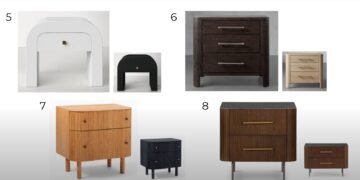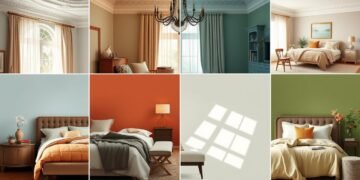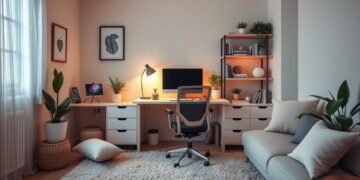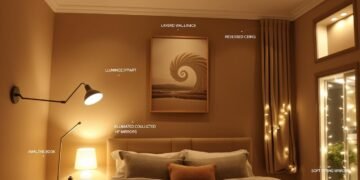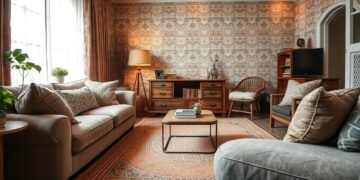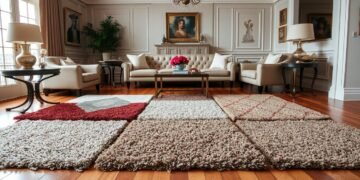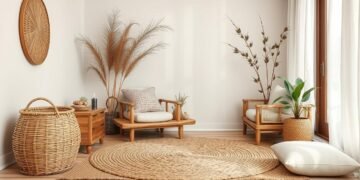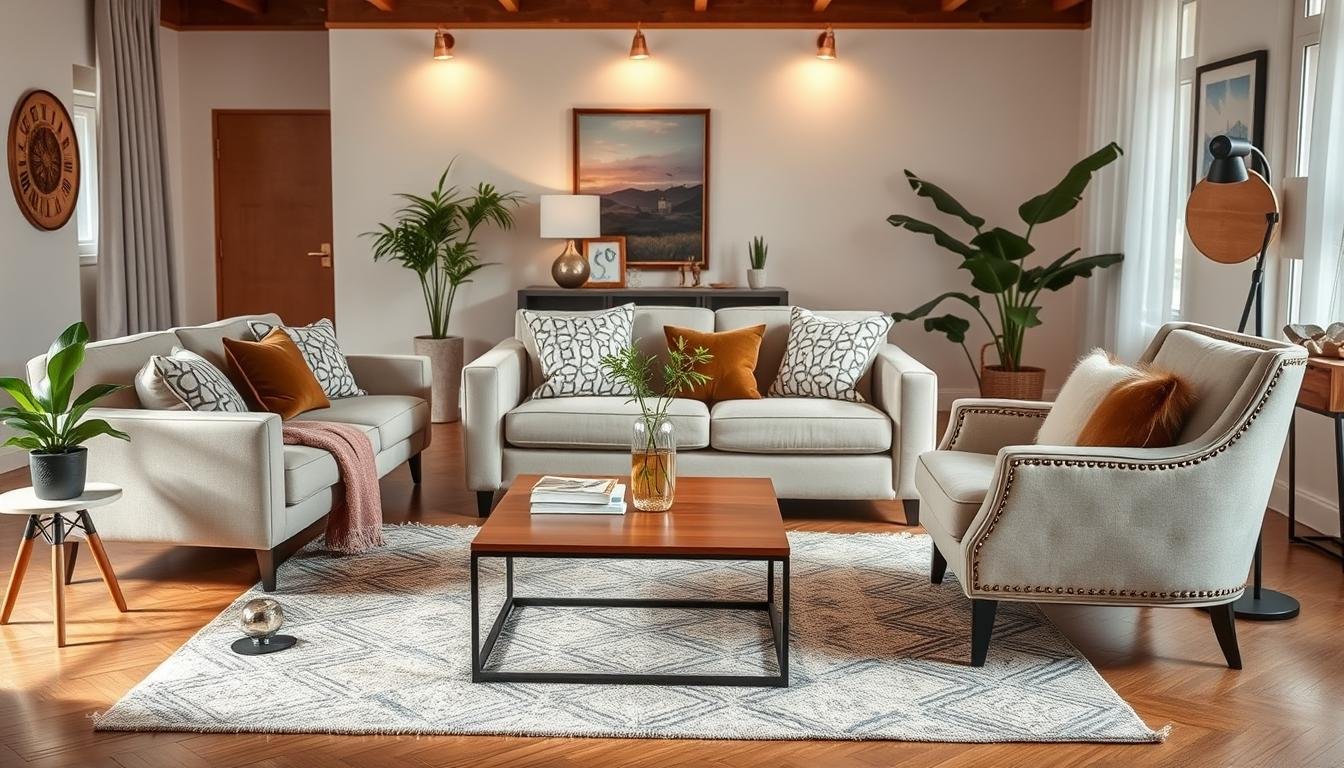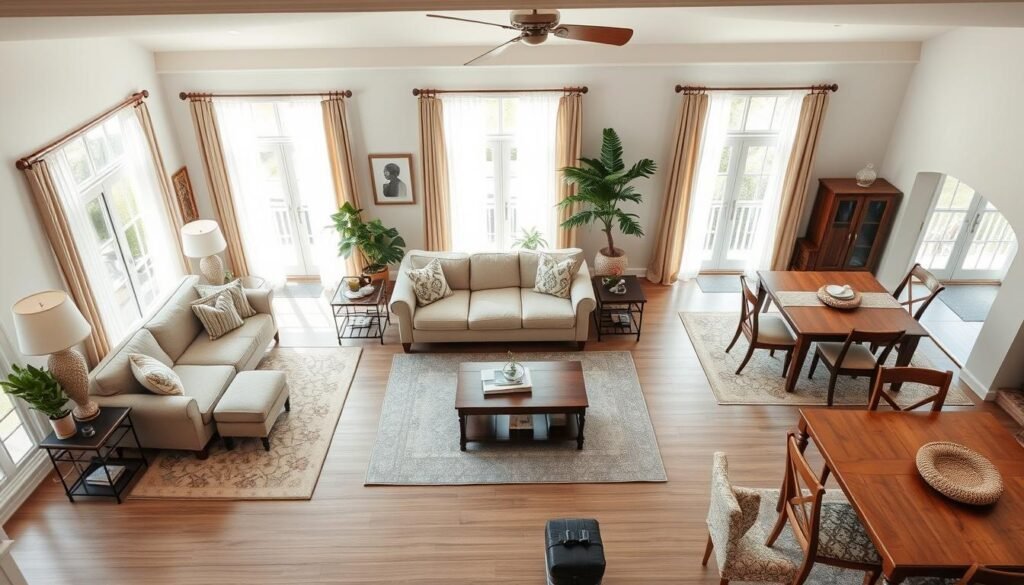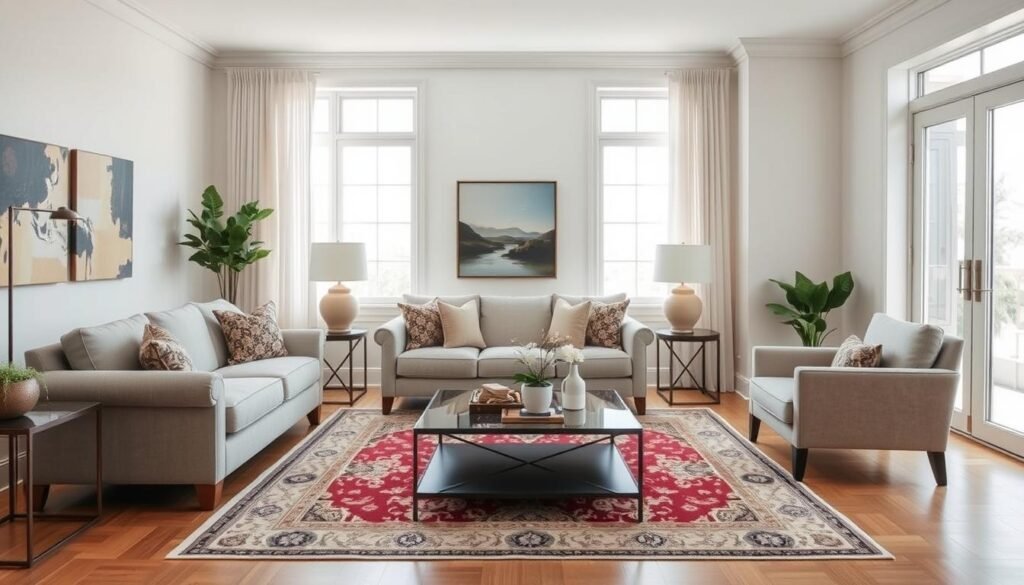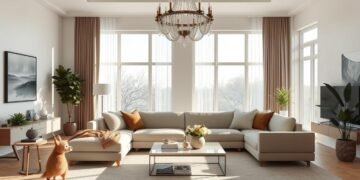Choosing the right furniture can be tough. You want your living space to look good and be easy to move around in. The secret is to pick furniture that fits your room perfectly.
Imagine a room where everything fits just right. It looks great and feels harmonious. This is possible with the right strategy. In this guide, we’ll show you seven ways to pick furniture that makes your space cozy and stylish.
Table of Contents
- 1 Understanding Room Measurements and Space Planning
- 2 Essential Clearance Guidelines for Comfortable Living
- 3 Choosing Furniture Sizes for Different Room Functions
- 4 The Impact of Furniture Shapes on Space Utilization
- 5 Scale and Proportion in Furniture Selection
- 6 Smart Solutions for Small Spaces and Tight Areas
- 7 Measuring Techniques for Perfect Furniture Fit
- 8 Multi-functional and Expandable Furniture Options
- 9 Lifestyle Considerations in Furniture Sizing
- 10 Conclusion
- 11 FAQ
- 11.1 Why is choosing the right furniture size important for my living space?
- 11.2 How do I take accurate room measurements for furniture planning?
- 11.3 What are the recommended clearance guidelines for furniture placement?
- 11.4 What are the typical furniture dimensions for different room types?
- 11.5 How does furniture shape impact space utilization?
- 11.6 What factors should I consider when selecting furniture based on scale and proportion?
- 11.7 How can I choose furniture that fits well in small spaces?
- 11.8 What measurements should I consider when moving furniture into my home?
- 11.9 What types of multi-functional and expandable furniture options are available?
- 11.10 How do I choose furniture sizes that accommodate my lifestyle and future needs?
- 12 Source Links
Key Takeaways
- Understand the importance of accurate room measurements for optimal furniture placement
- Learn how to create a detailed floor plan to visualize furniture arrangements
- Discover essential clearance guidelines for comfortable living and traffic flow
- Explore furniture sizing considerations for different room functions
- Discover how furniture shapes impact space utilization and visual appeal
Understanding Room Measurements and Space Planning
Creating the perfect furniture layout begins with knowing your space’s dimensions. Getting accurate room measurements is key to picking furniture that fits perfectly. Start by making an accurate floor plan. This should include the room’s length and width, and where doors, windows, and architectural features are.
After you have a detailed layout, think about the traffic flow patterns in the room. Make sure there’s enough space, at least 36 inches, for easy movement. This is very important in busy areas like entryways and hallways. Also, remember the architectural elements that might affect where you place furniture, like fireplaces or large windows.
By carefully planning for your room’s size, traffic flow, and architectural details, you can design a furniture layout that makes the most of the space. This approach to space planning helps you choose the right furniture sizes and arrangements. It ensures your design is both functional and visually appealing.
“The art of custom furniture design has been honed over 50 years at Contempo Space, allowing us to create pieces that seamlessly integrate with any space.”
Essential Clearance Guidelines for Comfortable Living
When setting up your furniture, making sure there’s enough space is key. This helps make your home feel more open and welcoming. Following standard clearance rules can improve how your rooms work and feel.
Start by leaving 36 inches (91 cm) between furniture and walls or other pieces. This space makes moving around easier and keeps your room from feeling too tight. It also boosts space efficiency and room circulation.
For seating, keep a gap of 24-30 inches (61-76 cm) between a coffee table and your sofa or chairs. This ergonomic distance makes getting up and moving around more comfortable.
- Make sure major walkways have at least 36-48 inches (91-122 cm) of space. This helps people move smoothly.
- In dining areas, leave 36 inches (91 cm) between the table and walls. This allows chairs to move easily and adds to space efficiency.
Following these guidelines helps create a balanced and furniture clearance-friendly home. Your space will be more comfortable, functional, and open.
The secret to a great living space is finding the right mix of ergonomics, space efficiency, and room circulation. By using these clearance tips, you can make your home more inviting and functional.
Choosing Furniture Sizes for Different Room Functions
Choosing the right furniture size is key to a great home. Each room, like the living room, bedroom, and dining room, needs special attention. This ensures a space that’s both comfy and looks good.
Living Room Furniture Dimensions
The sofa is the heart of the living room. Look for one that’s 84 to 108 inches wide. This size fits everyone comfortably. Armchairs should be 30 to 40 inches wide for plenty of room to relax.
The coffee table should be 36 to 48 inches wide. This size makes it easy to reach and keeps the room looking balanced.
Bedroom Furniture Proportions
The bed is the main piece in the bedroom. Choose a bed that’s 80 to 84 inches long for a great sleep. Nightstands should be 24 to 36 inches wide for easy access and storage.
For your dresser, pick one that’s 30 to 72 inches wide. This size fits all your clothes and personal items nicely.
Dining Room Space Requirements
The dining table is the room’s centerpiece. Make sure it’s wide enough for everyone to sit comfortably. For a round table, a diameter of 36 to 60 inches works for 4 to 8 people.
Rectangular tables should be 60 to 96 inches long. This size fits 6 to 10 people well.
Remember, these sizes are just a guide. Your home’s needs and your taste should guide your furniture choices.
The Impact of Furniture Shapes on Space Utilization
The shape of your furniture greatly affects how you use your living space. Round tables fit well in small areas, while rectangular pieces offer flexibility. Knowing how furniture shapes fit into your room layout is key to a good interior design.
Round tables are great for small spaces because they encourage conversation and help with movement. Their smooth edges are perfect for open spaces or cozy spots. Rectangular tables, by contrast, fit many room sizes and are great for dining and living areas.
Furniture shapes can also help divide a room into different areas. L-shaped sofas, for example, can mark off living and conversation zones in open layouts. Curved furniture adds a soft touch, while angular pieces bring a formal feel.
Choosing furniture means thinking about how it will affect your room’s look and flow. Understanding furniture shapes helps you create a space that’s both functional and beautiful. This way, your home reflects your lifestyle and taste.
| Furniture Shape | Impact on Space Utilization |
|---|---|
| Round Tables | Efficient in smaller spaces, promote conversation |
| Rectangular Tables | Versatile for various room sizes, adaptable to different needs |
| L-shaped Sofas | Define zones in open floor plans, create a sense of structure |
| Curved Furniture | Soften the overall aesthetic, contribute to a relaxed atmosphere |
| Angular Furniture | Add a sense of formality and structure to a space |
Thinking about furniture shapes can help you design a space that works well and looks good. Try out different shapes and layouts to find the best mix of style and function.
Scale and Proportion in Furniture Selection
Choosing the right furniture size for your home is key. It helps create a balanced and beautiful space. The size and shape of your furniture greatly affect how a room feels and works.
Balancing Large and Small Pieces
To design a great room, mix big pieces like sofas with smaller items. This balance makes your space look good and feel right. Think about your room’s size when picking furniture to match.
Creating Visual Harmony
It’s important to have furniture that looks good together. The size of each piece matters a lot. Color, shape, and patterns also play a part in how your furniture looks in the room.
Working with Ceiling Heights
High ceilings mean you can use taller furniture. This keeps the room feeling right. But, in rooms with low ceilings, choose furniture that’s not too tall to avoid making the room feel small.
Understanding furniture scale, proportions, and visual harmony helps you create a beautiful space. It fits well with your ceiling heights and interior design principles.
“Achieving the right balance between furniture scale and room size is the key to creating a harmonious and functional interior space.”
Smart Solutions for Small Spaces and Tight Areas
Living in a small space means making every inch count. Luckily, there are many small space furniture, compact furniture, and space-saving solutions to help. These can turn even the smallest areas into cozy, stylish spots. From furniture that does more than one thing to vertical storage, these smart picks help keep your space tidy and comfy.
Multi-functional furniture is a top choice for small spaces. Look for items like storage ottomans that serve as coffee tables or Murphy beds that fold up. Nesting tables and stackable chairs offer flexible seating that can be rearranged or hidden when needed.
Wall-mounted desks and fold-down tables are also great for saving space. They can be folded or hidden, freeing up floor space. Choose furniture with slim designs and clean lines to make rooms feel bigger and less cluttered.
Vertical storage, like shelves and cabinets, is key for small spaces. Use wall space to keep things off the floor and organized. Furniture with exposed legs can also make rooms feel more open.
The secret to making the most of a small space is to pick compact furniture and space-saving solutions that fit your needs. By using these smart design choices, you can turn tight areas into cozy, functional, and beautiful living spaces.
Measuring Techniques for Perfect Furniture Fit
Getting your furniture to fit perfectly is key for looks and function. Learning to measure accurately is essential. This guide will help you arrange furniture that matches your space perfectly.
Door and Hallway Considerations
Start by measuring your doorways and hallways carefully. Note the height, width, and diagonal depth. This ensures your furniture moves in smoothly. Watch out for architectural details or obstructions that might block the way.
Window and Built-in Feature Measurements
Then, focus on windows and built-ins. Measure their heights and widths. This helps place your furniture without blocking or altering their look.
Creating Template Layouts
To plan your furniture layout, make cardboard templates. Use painter’s tape on the floor to test different setups. This way, you can avoid problems before moving the furniture.
Spending time on measurement and planning is worth it. It leads to a space that looks good and works well, showing off your furniture.
| Measurement Tool | Recommended Uses |
|---|---|
| Metal Tape Measure | Accurately measure width, depth, and height of furniture pieces |
| Straight Edge Ruler | Measure diagonal depth and height for evaluating entry challenges |
| Laser Measuring Device | Quick and precise measurements over larger distances or in tight spaces |
| Pencil and Paper | Record measurements accurately during the furniture measurement process |
| Level Tools | Verify horizontal and vertical balance to ensure furniture sits correctly |
Multi-functional and Expandable Furniture Options
In today’s world, we all want to save space. That’s why multi-functional furniture and expandable pieces are so popular. These versatile designs help you use your space better and adapt to your changing needs. Let’s look at some smart ways to make your home more efficient and stylish.
Begin with your dining area. An expandable dining table is perfect for hosting guests. Add stacking chairs that can be tucked away when not in use. This makes your dining area both flexible and space-saving.
In your living room, a sofa bed or daybed is a great choice. It offers both comfort and a place for guests to sleep. Don’t forget ottomans with secret storage for your essentials.
For coffee tables, look for ones that can grow or change size. Modular furniture systems are also excellent. They let you change your furniture to fit your needs and style.
The secret to saving space is choosing the right furniture. Go for multi-functional furniture and expandable pieces that fit well in your home. Pick quality, space-saving designs that look good and work well for a long time.
Lifestyle Considerations in Furniture Sizing
Choosing the right furniture for your home is key. Think about your lifestyle and how it affects your space. The right furniture can make your home both functional and comfortable.
Family Size and Entertainment Needs
If you have a big family or like to host guests, you need furniture that fits. Go for big sofas or sectionals to ensure everyone has room. About 70% of people in small rooms choose loveseats and compact sofas. But, 65% of those with bigger rooms prefer sectionals.
Future Growth Planning
Think about how your needs might change in the future. If you’re expecting kids or want to age in place, pick furniture that can grow with you. 60% of people choose dual-purpose items like storage ottomans or sofa beds to save space and meet changing needs.
Accessibility Requirements
Make sure your furniture meets any mobility or accessibility needs. Look for pieces that are adjustable, sturdy, and easy to use. This makes your home more comfortable and welcoming for everyone.
By carefully choosing furniture, you can make your home fit your lifestyle perfectly. It’s all about finding furniture that suits your family size and future plans. The right furniture can turn your home into a harmonious and accessible space.
Conclusion
Choosing the right furniture sizes is key to making your living spaces comfortable and stylish. Think about the room’s size, how much space you need, and what fits well together. Also, consider how your lifestyle will change over time.
Most people believe that furniture greatly affects a room’s feel and look. Following design rules and expert advice helps you pick the best furniture. This way, your furniture will match your home’s style and flow well.
When picking furniture, think about the room’s size and your lifestyle. Look for pieces that are both functional and stylish. This will help you create a space that looks great and meets your needs now and in the future.
FAQ
Why is choosing the right furniture size important for my living space?
How do I take accurate room measurements for furniture planning?
What are the recommended clearance guidelines for furniture placement?
What are the typical furniture dimensions for different room types?
How does furniture shape impact space utilization?
What factors should I consider when selecting furniture based on scale and proportion?
How can I choose furniture that fits well in small spaces?
What measurements should I consider when moving furniture into my home?
What types of multi-functional and expandable furniture options are available?
How do I choose furniture sizes that accommodate my lifestyle and future needs?
Source Links
- 7 Ways to Choose the Right Size Dining Table for Your Space
- 7 Tips for Choosing the Perfect Dining Room Set | The Furniture Mall
- 7 Things to Do Before Buying Furniture | Columbia MO
- Plan Your Room: Understanding Room Layout and Furniture Placement
- Discover the Perfect Fit: A Guide to Getting the Right Furniture Dimensions
- How To Design A Living Room – Our Go-To Rules (And When It’s Ok To Break Them) – Emily Henderson
- A Comprehensive Guide to Choosing Furniture Using Measurements
- The Interior Design Institute
- IndiaCircus
- Impact of Furniture on Interior Design
- The Impact of Furniture Layout on Interior Design
- Selecting Furniture: Think About Scale — Kelsey Lee Interiors
- Room Proportion: Creating Scale and Balance When Designing Your Home
- Mastering Balance: A Guide to Scale and Proportion in Interior Design – Landry Designs
- 15 Transforming Furniture Solutions for Small Spaces
- 31 Creative Small-Space Furniture Ideas for Any Room in Your House
- 15 Things That Make Their Tiny Apartments Feel Bigger
- How to Measure Furniture Size
- Complete Furniture Measurement Guide: Essential Tips for Perfect Fit
- 8 Tips for Choosing Multi-Functional Furniture in Small Spaces
- Multipurpose Furniture
- The Rise of Multifunctional Furniture: Space-Saving Solutions for Modern Homes
- Choosing the Perfect Furniture for Your Living Room: 3 Key Factors to
- 8 Factors to Consider While Choosing Furniture for Your Home
- 9 Key Factors to Consider for Your Furniture Selection
- Complete Furniture Measurement Guide: Essential Tips for Perfect Fit
- A Comprehensive Guide on How to Choose the Right Furniture for Your Home. – Nilesh Sawant








